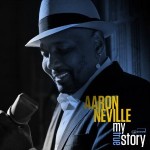My True Story started out as Aaron Neville’s “doo-wop project” but became something else. On a promotional video made for the album, Blue Note label president and album co-producer Don Was tells part of the story. He gathered a list of about 100 possible tunes to record, went over them with Neville and selected the top 12. Then he gave Keith Richards a ring and asked if Richards would like to co-produce, play guitar and lead the band. Buy on AmazonBuy on iTunes
[iframe class=”spotify-right” src=”https://embed.spotify.com/?uri=spotify:album:3CT7Qcoolyiy2Z8n5FEItO” width=”300″ height=”380″ frameborder=”0″ allowtransparency=”true”]
But that’s exactly where the project jumped the tracks, or as Was explains it, “I [first] heard it as a collection of ballads, and somehow, we just went off list … Aaron started improvising [the song selection], and it became almost stream-of-consciousness, it kind of took a rock ’n’ roll turn I think.” From the artist’s point of view, it simply became an Aaron Neville album, maybe the first real Aaron Neville album he’s ever made, because this time around, nothing but the music mattered, and the music coming from Neville’s head, from his heart and more importantly, from his soul. “I think this music has been ridin’ on my heart for all these years, that’s why I try to put a little bit of it in everything I do,” Neville says. “But this time, I wanted to respect the music, I didn’t go too far away from the original, I just wanted to put a little bit of my own inflections in it, what comes from my heart.”
My True Story has become, in fact, Aaron Neville’s true story, the first of what he hopes will be a series of albums done exactly the same way (Neville says another batch of tunes from the My True Story sessions is cut and ready to go). This time around there are a dozen songs, chosen from material that spans a dozen years—from 1952 to 1964—and features, at its apex, the Ronettes/Phil Spector masterpiece “Be My Baby,” followed by Clyde McPhatter’s “Little Bitty Pretty One,” Little Anthony and The Imperials’ “Tears on My Pillow” and The Drifters’ “Under the Boardwalk.” There are also unexpected ringers thrown in, such as Curtis Mayfield’s “Gypsy Woman” and “Ruby, Baby”—done first by The Drifters, then Dion and the Belmonts and again, much later, by Steely Dan co-founder Donald Fagen on his 1982 solo album The Nightfly. Also present: a couple of expected, gorgeous ballads, including “This Magic Moment” and “Goodnight, My Love.”
What there isn’t is a drop of sentimentality. Neville keeps his promise to reign in his trademark flourishes and vocal acrobatics. Every arrangement serves every song perfectly, and the effect is less what we’ve come to expect from an Aaron Neville album and more like a group effort that reminds us how good these songs are, played straight, a half century after they were first written.
On the songs’ universality, Neville recalls how Paul Simon dropped by the sessions and all three musicians—Neville, Simon and Richards—carried on a musical conversation “like we all grew up on the same block.” As for their quality, Neville believes the music from this era is worthy of an addendum to The Great American Songbook. I second that emotion.




